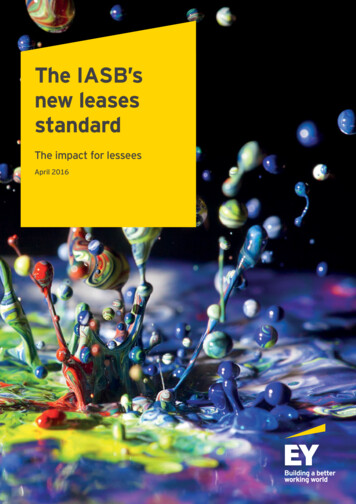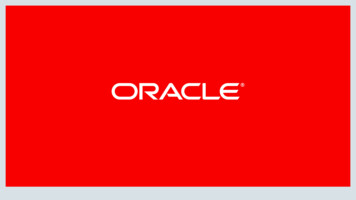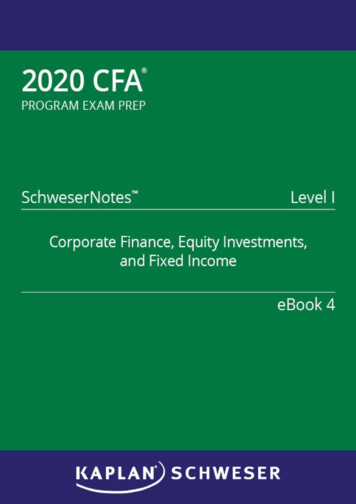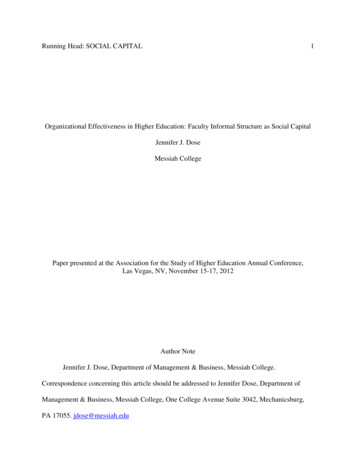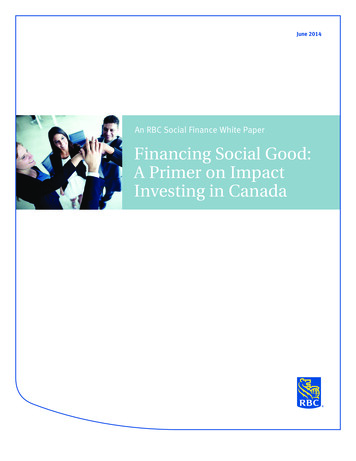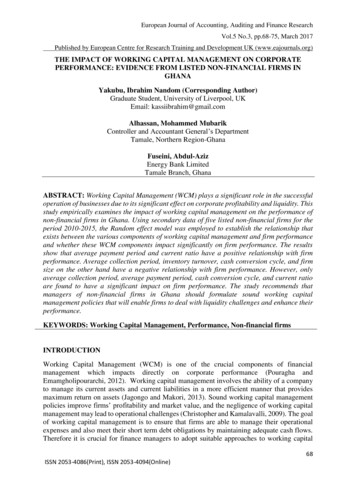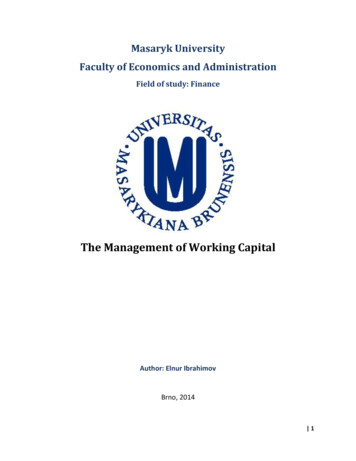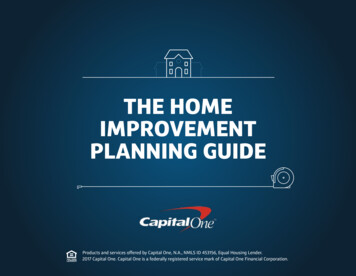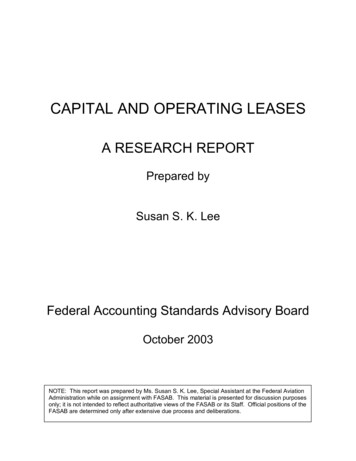
Transcription
CAPITAL AND OPERATING LEASESA RESEARCH REPORTPrepared bySusan S. K. LeeFederal Accounting Standards Advisory BoardOctober 2003NOTE: This report was prepared by Ms. Susan S. K. Lee, Special Assistant at the Federal AviationAdministration while on assignment with FASAB. This material is presented for discussion purposesonly; it is not intended to reflect authoritative views of the FASAB or its Staff. Official positions of theFASAB are determined only after extensive due process and deliberations.
About the AuthorSUSAN S. K. LEESusan Lee has worked at the Federal Aviation Administration since 1991, serving as the SpecialAssistant to the Chief Financial Officer and later the Special Projects Officer to the Director,Office of Financial Management. In these roles she has worked on both accounting and budgetmatters and represented the CFO and the Director of Financial Management in meetings andvarious task groups. Recently, Susan was the audit liaison for the financial statements audit anddirected the preparation of FAA’s Performance and Accountability Report and supplementalHighlights document.Previous to the FAA, Susan worked at the National Archives and Records Administration as theagency’s Director of Accounting and Director of Budget. She worked for the TreasuryDepartment for 16 years, where she was the Director of the Federal Financial Systems Program,in charge of a staff who worked with the Office of Management and Budget (OMB) and the 23largest Federal agencies to provide policy direction and to oversee agencies’ progress inimproving their financial systems. She served as Treasury’s Fiscal Service representative on theChief Financial Officers’ Council, the CFO Subcommittee on Financial Systems and InformationNeeds, and the Systems Committee of the President’s Council on Management Improvement.She also worked at the Office of Management and Budget for two years, during which shedrafted OMB Bulletin No. 83-21, which was OMB’s directive on using credit bureaus for debtcollection, and led a government-wide task force to implement provisions of the Debt CollectionAct.An active supporter of the Association of Government Accountants (AGA), Susan has been thePresident of the Washington Chapter, National Treasurer, Regional Vice President, NationalExecutive Committee member, and a permanent member of the AGA National Board ofDirectors. She was elected three times to be on the Board of Directors of the AmericanAssociation of Budget and Program Analysis, and served as their Vice President for Membershipand Vice president for Communications. She has been a member of the Brookings InstituteAccountants’ Roundtable and was Programs Chair for the Comptrollers’ Roundtable. WhenAGA established the Certified Government Financial Manager (CGFM) designation, Susan wasa subject matter expert who helped AGA to develop the knowledge requirements and the trainingmaterials used to prepare individuals for the professional examination. She graduated from theUniversity of Maryland in 1976 and was a Certified Public Accountant from 1994 to 2002.2
TABLE OF CONTENTSTABLE OF CONTENTS . 3INTRODUCTION. 6Purpose and Objectives. 6Scope. 6Background. 7What is a lease?. 8What is covered in FASAB guidance on leases?. 8How is FASAB guidance different from others?. 8Classifications of Leases. 9Capital Lease. 10Sales-Type Lease, Direct Financing Lease, and Leveraged Lease . 12Operating Lease . 13How does the lessee report and account for leases? . 13Capital Lease. 13Operating Lease . 14How does the lessor report and account for leases? . 15What other lease accounting guidance is provided by other standard-setting entities but notcovered by FASAB? . 16Leases Involving Real Estate . 16Leases Between Related Parties . 17Sale-leaseback Transactions . 17Subleases and Similar Transactions . 19Leases in a Business Combination . 19Fiscal Clauses . 19USE OF LEASES BY FEDERAL ENTITIES . 21Types of Leases and Lease-Like Arrangements . 22Operating Leases. 23Patent and Trademark Office (PTO) Building. 23Department of Transportation Headquarters Building . 23Boeing 767 Tankers . 23Sale-Leaseback . 24Charlestown, WV, Federal Building. 24Lease-Leaseback . 24Public-Private Partnerships . 253
Veterans Affairs - Houston Regional Office Collocation. 26Veterans Affairs - Office Collocation and Parking Garage, Chicago. 26Oak Ridge National Laboratory. 27Outleases . 27Galveston Customhouse. 27Maine Lights Program . 27U.S. Tariff Building . 28Share-in-Savings Contracts. 28Eisenhower Center . 28Heating, Ventilation and Air Conditioning System Upgrade - Commerce . 28Special-Purpose Public/Private Ventures. 28DOD’s Military Housing . 29Other Public/Private Ventures . 30Statutory Authority . 30Public Private Partnership Act of 2003. 31Federal Property Asset Management Report Act of 2003 . 31RELEVANT ISSUES RELATING TO LEASE ACCOUNTING . 33Department of Justice’s Specific Concerns . 33Global Issues. 34With the growing use of operating leases to meet long-term commitments, should theaccounting, and reporting of such leases be revised? . 34How do you determine whether an arrangement is a lease? . 36In a public/private venture, should the special-purpose entity that is essentially establishedand controlled by the Federal agency, be consolidated into an agency’s financialstatements? . 37Should Federal agencies disclose information on operating leases with cancellation clauses?Do they? . 39Does FASAB need to provide additional guidance on leases?. 39NEXT STEPS . 42Prepare Staff Position Paper . 42Expand FASAB Guidance on Leases . 42Monitor Status. 42Further Analysis. 42Establish a Network of Agency Contacts . 43CONCLUSION . 43APPENDIX NO. 1: CAPITAL AND OPERATING LEASES AND LEASEHOLDIMPROVEMENTS SKELETON PROJECT PLAN RESEARCH PHASE. 46APPENDIX NO. 2: LIST OF AUTHORITATIVE LITERATURE . 474
APPENDIX NO. 3: LIST OF CONTACTS. 49APPENDIX NO. 4: COMPARISON OF CRITERIA FOR CLASSIFYING A LEASE AS ACAPITAL LEASE . 50APPENDIX NO. 5: DETERMINING LESSOR’S TYPE OF LEASE -FASB. 53APPENDIX 6: FOOTNOTE DISCLOSURE: EXTRACT FROM OMB BULLETIN NO.01-09 . 54APPENDIX NO. 7: ACCOUNTING FOR A CAPITAL LEASE BY A LESSEE. 57APPENDIX 8: ILLUSTRATIVE CAPITAL LEASE SCENARIO . 58APPENDIX NO. 9: ILLUSTRATIVE SCENARIO FOR OPERATING LEASE WITH ACANCELLATION CLAUSE. 68APPENDIX NO. 10: CLASSIFYING LEASES INVOLVING REAL ESTATE . 76APPENDIX NO. 11: FLOW DIAGRAM OF A PUBLIC/ PRIVATE VENTURE . 78APPENDIX NO. 12: ISSUES - DEPARTMENT OF JUSTICE, OFFICE OF INSPECTORGENERAL. 79APPENDIX NO. 13: EXCERPTS ON LEASES FROM SFFAS NO. 5 ACCOUNTINGFOR LIABILITIES OF THE FEDERAL GOVERNMENT. 84APPENDIX NO. 14: EXCERPTS ON LEASES FROM SFFAS NO. 6 ACCOUNTINGFOR PROPERTY, PLANT, AND EQUIPMENT . 86BIBLIOGRAPY FOR LEASES . 885
CAPITAL AND OPERATING LEASESRESEARCH PHASEINTRODUCTIONPurpose and ObjectivesThe purpose of this research is to recommend whether or not additional FASAB guidance onleases is needed. Based on the project plan, (see Appendix No. 1), the objectives of the researchare two-fold:1. To develop a summary paper that permits staff and the Board to familiarize themselves withlease accounting under FASAB, FASB, GASB and inte
agencies, accounting for leasehold improvements, and the impact of a funding clause in a lease agreement. During this era of funding constraints, renting under a lease contract, in lieu of purchasing an asset, has reemerged as a popular means for federal agencies to acquire the use of assets. From the vantage of an agency, an operating lease arrangement can be very attractive because the .
